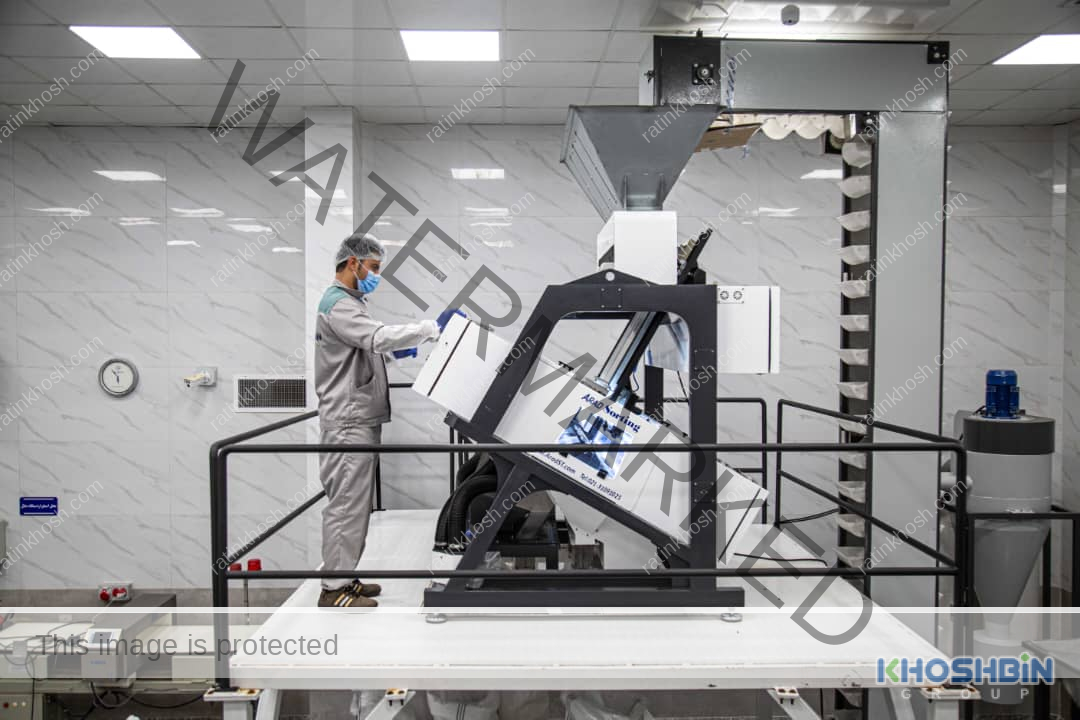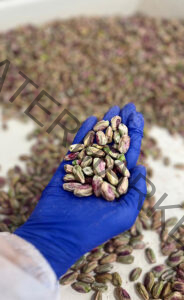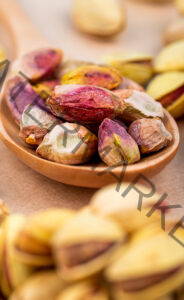Iranian Pistachios
What Makes Ratin Khosh Outsanding in the Iranian Pistachios Market?
▪️Industry Expertise
▪️Premium Product Quality
▪️R&D and Innovation Excellence
▪️Strong Supplier Relationships
▪️Market Orientation
▪️Global Reach

Over the years, we have dealt with thousands of prospective buyers and served hundreds of customers around the world. And we have learned a lot about international buyers’ concerns when it comes to importing pistachios from Iran.
Whether you are buying Iranian pistachios for the first time, or just have a burning question as to how Iranian pistachios work, this article may help. I hope price is NOT the only factor for selecting your supplier. Let’s face it, you can’t put a price on quality!!
First thing first, Iranian pistachios are praised for their strong, nutty taste and aroma. They are often recognized by a cheerful smile, purplish red skins and distinctive nutty flavor. Iranian pistachios have dominated the pistachio up-market for years as the “happy nuts”. Even today with American pistachios sold on every corner, Iranian pistachios are holding a strong market position.
Read more:pistachio paste wholesale
Understanding the Types of Iranian Pistachios: Ahmad Aghaei, Fandoghi, Kalleh Ghouchi, and Akbari
Iran cultivates over 90 distinct varieties, but only five are known to international buyers. Almost all pistachios exported from Iran belong to one or any of these five families of pistachios. Unique characteristics of the five-known Iranian pistachios include the following. Ahmad Aghaei is known for its elongated shape and wide open mouth. Fandoghi, or round pistachios, are small and popular for snacking due to their crunchiness. The Fandoghi kernel is sought-after by many importers and chefs due to its cute, round shape. The Kalleh Ghouchi features a large, round appearance and is favored also for its in-shell shape. Lastly, Akbari pistachios are super long, featuring a big kernel and the big smile characterizing all Persian pistachios. Akbari is suitable for both culinary applications and decorative purposes.

Read more : shelled pistachios bulk
Why Choose Iranian Pistachios? Key Advantages for B2B Buyers
Iranian pistachios (Persian pistachios) are an exceptional choice for foreign B2B buyers. Thanks to their rich variety and exceptional taste and flavor, the market for Iranian pistachios is holding strong. Not only that, Iranian pistachio derivatives also provide more than just a snack. Now they are gaining advantage as key ingredients especially in the dessert market. KHOSHBIN pistachio paste, a strategic product by Ratin Khosh company, is considered a game changer in the ice cream and confectionery sectors. But application possibilities are endless, from luxurious garnishes in confections to toppings in baked goods.
Iranian pistachios showcase distinctive visual and taste profiles which make them ideal for creating differentiated product lines and simplifying sourcing pistachios from Iran. Ahmad Aghaei (elongated and green), Kalleh Ghouchi (large and round), and Akbari (super long). Additional varieties like Badami (slim) and Fandoghi (small round) offer unique textures and flavors, providing flexibility for different products.
Additionally, Iranian growers and manufacturers practice a conventional grading system and reliable supply chain that enable international buyers to choose from a vast variety of options for high-end products. This flexibility, combined with Iran's expertise in pistachio cultivation and quality control, makes Persian pistachios a valuable ingredient for snack, confectionery, bakery, chocolate, and ice cream industries worldwide.

Read more : green peeled pistachio kernel
What are the Standards of Quality and Taste in Iranian Pistachios?
The standards of quality and taste in Iranian pistachios are characterized by several key factors to make sure the “happy nuts” meet international market expectations. There are certain qualifications we obtain governing how we produce such as ISO, Halal and HACCP. There are also standard certifications from Food and Drug Administration (FDA) and Iranian Standard Organization to make sure pistachios are suitable for export. Farmers and suppliers use traditional qualifying factors among themselves such as region, grower or farmer, size, shape, color, and flavor. Experientially, suppliers know where to locate the best quality pistachios.
Regional factors determine the taste, color and usability of pistachios in the production of pistachio derivatives. Pistachios grown in one region may differ slightly from pistachios of other regions in terms of color, taste and appeal. For example, slivers produced, let’s say, in Qazvin look larger and greener than those from Kerman.
However, the most qualifying factors are determined by the manufacturers themselves depending on who they buy from and the market they are targeting. Some of these standards include the minimum presence of damaged kernels, aflatoxin level, appropriate moisture levels, and minimal defects. Storage conditions also play a significant role in maintaining the freshness and taste of the nuts during transport. Factors such as packaging and labeling are negotiated between sellers and buyers.
Read More:pistachio wholesale price in iran

What is the Price of Iranian Pistachios?
Borrowing from the opening phrase about the price, quality comes with a price. In general, Iranian pistachios are typically positioned in the top-market segment. So, always expect a bigger price tag for the reasons we have mentioned throughout this article.
In general, the price of Persian pistachios varies based on region, size, quality, processing and treatments, variety, and market conditions. Premium varieties like Ahmad Aghaei, Akbari and Kalleh Ghouchi typically target the high-market with prices ranging from $6 to $12 per kilogram due to larger demand. In contrast, more economical varieties such as Fandoghi and Badami are generally priced around $4 to $8 per kilogram for lower markets.
More recently, however, Iranian suppliers are gradually reducing their export of raw or whole in shell pistachios, and shifting toward pistachio derivatives such as paste, kernels and pieces. For these, buyers pay an extra cost of added values. The prices range from as low as $16 to as high as $42 depending on the amount of work that goes into the production.
Green pistachio kernels may have the largest price variation due to their wide color range.
Read more :Akbari Pistachios
Complete Journey of Pistachios: From Cultivation to Processing
Growing pistachios is a long and careful process that starts with patience and precision. The trees thrive in dry, sunny climates, where farmers monitor the soil closely to ensure the right balance of moisture and minerals. Harvesting usually takes place in late summer or early autumn, when the shells naturally split open—a sign that the nuts are ready. Once picked, the pistachios are quickly hulled, dried, and sorted to preserve their flavor and freshness. The final step—roasting or packaging—turns this delicate crop into one of the most prized nuts in global markets.
What is the Best Time to Import Iranian Pistachios?
We maintain a steady supply of pistachios through the year due to advanced storage facilities and processing machines. Traditionally, importers and wholesalers flock to Iran, typically from late August to early October, in the hope of securing their purchase of new crops. This is when international buyers can access the best Iranian pistachios directly from reliable producers or manufacturers of pistachio derivatives. And the time when consumers have the chance to taste the new crop of pistachios after a year-long wait.

Read more :round pistachio supplier
What are the Characteristics of a Reliable Supplier of Iranian Pistachios?
As a rule of thumb, the quality of the pistachios is often tied to the reputation of the supplier. Well-known suppliers are more likely to provide higher quality products. For those interested in where to buy Iranian pistachios, reputable suppliers can often be identified through their strong online presence, customer reviews and established distributors. In general, a reliable supplier of Persian pistachios should exhibit the following key characteristics:
- Reputation and Track Record: A solid reputation with proven consistency in quality and timely delivery.
- Quality Certifications: Adherence to international quality standards, such as ISO or HACCP.
- Strong Farmer Relationships: Established connections with local farmers for access to fresh, high-quality nuts.
- Distribution Channels: Well-developed distribution networks for efficient and timely delivery.
- Experience: Significant industry experience to ensure a reliable supply chain of quality pistachios, skillful handling and processing, and timely delivery.
- Facilities and Capabilities: Modern processing facilities and technology that enhance product quality and efficiency for ingredients such as slivers, paste, kernels, powder, and granules.
- Diverse Product Range: A wide variety of grades and forms to meet specific needs in the market such as the chocolate and bakery sectors.
- Research and Development (R&D): An active R&D component for product innovation.
- Market Orientation: Awareness of market trends and consumer preferences to customize offerings.

Why Iranian Pistachios Are the Best Choice for Confectionery and Culinary Uses
Iranian pistachios are ideal for confectionery and culinary applications for three main reasons. Iranian pistachios are prized for their rich, buttery flavor and high oil content. The higher oil content makes them suitable for roasting which further enhances the flavor. Iranian pistachios boast visual appeal due to their vibrant green color of the kernel and purple skin. With diverse varieties suited for different uses, Iranian pistachios offer unmatched quality and versatility in the food industry.
Competitive Advantages of Iranian Pistachios (vs. US & Turkish Pistachios)
| Criteria | Iranian Pistachio | US Pistachio | Turkish Pistachio |
|---|---|---|---|
| Variety & Taste | Rich in flavor, high oil content, multiple cultivars (Ahmad Aghaei, Akbari, etc.) | Mild flavor, lower oil content | Smaller size, strong taste |
| Size Range | Wide size options (20/22 to 32/34) suitable for different markets | Mostly uniform size (21/25) | Generally smaller sizes |
| Price Competitiveness | More affordable due to domestic production scale and currency advantage | Higher prices due to processing and labor costs | Moderate pricing |
| Availability | High production capacity, flexible supply for large orders | Seasonal availability, limited global supply | Limited production volumes |
| Export Experience | Over 100 years of export history, strong know-how in international trade | Advanced logistics, modern packaging | Limited export reach |
| Processing & Grading | Traditional and modern processing options with detailed grading systems | Highly industrialized, consistent grading | Mostly traditional processing |
| Certification Options | Halal, ISO, HACCP, Organic available on request | USDA, Non-GMO, Organic | Limited certification access |
| Market Customization | Packaging & roasting styles tailored for specific regions (e.g., EU, China, GCC) | Standardized formats | Less adaptable to foreign markets |
| Shelf Life | Long shelf life due to natural drying methods | Good shelf life with artificial drying | Moderate shelf life |
| Cultural Relevance | Deep culinary and gifting culture in Middle East and Asia | Preferred in Western markets | Popular locally |
What is the Advantage of Iranian Pistachios Compared to Pistachios from Other Countries?
Iranian pistachios are famous for their wide range of varieties, superior flavor, purple skin, vibrant green color, and creamy texture. These are largely attributed to the country's unique climate and soil conditions affecting pistachios for hundreds of centuries. The diverse range of varieties, notably AKbari, Ahmad Aghaei, Fandoghi, Badami and Kalleh Ghouchi, offers various shapes and tastes that appeal to differing culinary applications. Additionally, Iranian pistachios often contain higher healthy fat content, enhancing their taste profile compared to those from other regions like the United States or Turkey. This is a determining factor in the minds of healthy-conscious consumers.
What is the minimum order quantity (MOQ) of pistachios that an Iranian supplier can offer?
The minimum order quantity varies among our products. For pistachio paste, the MOQ is 300 kg, which is typically the size of a pallet. For pistachio kernels and pieces, the MOQ is 400–500 kg to fill a large pallet. Of course, the MOQ is lower if pistachio products are ordered collectively to add up to 500 kg.
Read More: the pistachio factory